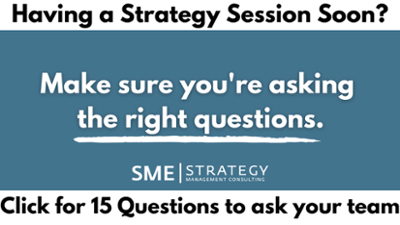
SME Strategy is a strategy consulting company that specializes in aligning teams around their vision, mission, values, goals and action plans. Learn more about how we can help you and your team create a strategic plan with our strategic planning and implementation services.
Your strategic planning session could be the most significant event of the year for your organization - let’s make sure it’s done right.
Whether your organization completes the strategic planning process once every 1 year, 3 years or 6 months, it’s no doubt an important moment with game changing potential. During an average strategic planning process, management and key staff are off site (or online) for consecutive days, away from their daily responsibilities. On top of that, organizations can often spend a considerable amount of money on travel expenses, consultants and facilitators.
If you’re developing a strategic plan for your organization without the help of a consultant or facilitator, this mini-guide will be even more important for you. The time it takes to engage in strategic planning is precious, and it’s possible that some members of your team will be dubious of the process from the start.
When developing a strategic plan in-house, your organization will be presented with other challenges that are important to consider. Without the help of a facilitator, someone from your team will likely be leading the session. This means they will be unable to truly participate, and they may have a hard time remaining unbiased. On top of that, members of your team may be hesitant to voice their opinions in a strategy session being led by their boss.
In order for your organization to reach its ideal future and crush its goals (all while saving time and money), it’s important to complete the strategic planning process properly the first time around.
We can help you align your team around a clear vision, mission, values, goals and action plans,
so you can lead your organization more effectively and get better results.
Here are 4 crucial mistakes to avoid when developing a strategic plan:
1. Focusing on too many things
One of the most common problems we see with strategic plans is an excess of strategic priorities and things to focus on. This problem relates directly to the definition of strategy itself - which is the act of choosing what to focus on. This is one of those problems that is hard to avoid without the help of a meeting facilitator. Everyone has their priorities that they feel should be a central focus to the organization, and it isn’t always easy to tell a team member ‘we aren’t going to focus on that this year’.
Strategic priorities are general areas of focus (not to be confused with goals). Some common strategic priorities we see include: increase revenue, launch a new product, develop a stronger workplace culture, improve customer service, and so on.
When it comes time to set strategic priorities for your organization, it’s important to consider only the most important things you should be doing. This means choosing just 3-4 things to focus on that will move your organization to its ideal future. For a more in-depth explanation of how to set strategic priorities, watch this video:
2. The vision is unclear & your people can’t buy-in
When looking to the future and deciding where to take the organization, developing a vision is the first step. The vision is what you want the organization to look like at some future date. Almost all organizations whether big or small have a vision, and they may even be well thought out and reasonable. The mistake organizations make is having a vision that doesn’t make sense to their people, which means they can’t buy-in.
When developing a vision that your people can get behind and buy into, there are a couple important things to keep in mind. Firstly, there should be a realistic timeline attached to the vision. If your ideal future is 1 year from now, you aren’t thinking big enough, but if it’s 10 years from now, most of your people won’t even see themselves in a part of that future.
Next, your vision should be both measurable and achievable. It may be uncomfortable to attach numbers to your ideal future, but it needs to be clear where exactly the organization is going, and how close it is to reaching success. This way, your people will be able to gage the success of the organization and realize how the work they do contributes to the vision.
Lastly, the vision should be both inspirational and motivational. It should rally your people around a single target, and act as a guiding light. With all your people bought into the vision, the organization has the best chance of executing its strategies and reaching its ideal future.
For further instruction on developing a vision your team can buy into, watch this video:
3. Goals are not SMART
Goal setting is one of the most important pieces of the strategic planning process for the individual members of your organization. This is what they’ll be working towards on a day-to-day and month-to-month basis. As they go about their work, your people should have the goals they’re responsible for top of mind, as to influence the decisions they make and the actions they execute.
Common types of ill-advised goals we see regularly include: increase sales, improve customer service, provide frequent reporting, and so on. The problem with these goals is that they aren’t SMART. SMART goals are Specific, Measurable, Achievable, Realistic, & Time-bound. This means your goals should have at least one person responsible for each, there should be an end date, and it should be very clear after whether you have met the goal or not.
4. No system for accountability or tracking
Once the strategy session is complete and your people return to their day-to-day work responsibilities, it’s very easy for them to lose interest in or even forget about the strategic plan over time. In fact, we see this happen often. It doesn’t matter how sound and well put together the plan is, it is at risk of collecting dust on a shelf or being lost on someone’s computer without a plan for accountability and tracking.
The first step is to develop a system for holding your people accountable, which should include a regular meeting cadence. This way, the strategic plan will remain top of mind throughout the year, and they will have to remain committed to their goals and actions. These weekly, monthly, or quarterly meetings are a great way to stay on top of things and re-motivate your people to crush their goals.
You’ll also want to have a way for your people to track and monitor their goals and the overall strategic plan on a continuous basis. Some organizations rely on spreadsheets, which are less costly but also less practical and functional, while others use a special software that tracks and monitors the plan in a user friendly way. Here’s a more detailed comparison of tracking a strategic plan with a spreadsheet vs. a software.
Whether you’re part of a large or small organization, your strategic planning session is a chance to set the organization on a path to success for years to come. It will certainly cost you time and probably money, so it will be crucial to make the most of it and get it right the first time around. Avoid these four common mistakes and your organization will be well on its way to success. If you have any questions about the strategic planning process, or want to share an experience you had during a strategy session, feel free to send me an email and I’d be happy to chat!




